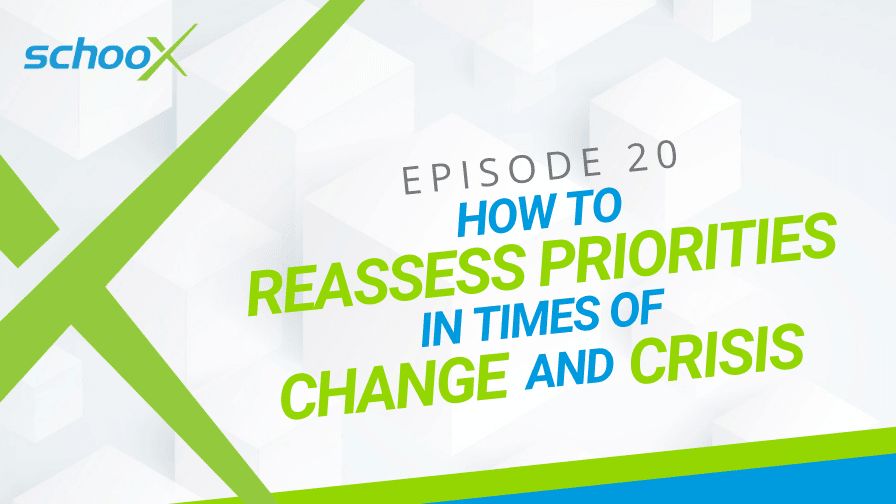03 March 2021
5

How often do you reassess your priorities, both in business and your personal life?
In times of change or crisis, many of us make the mistake of keeping those priorities and plans the same. However, if the world/the business/your life has changed, shouldn’t those priorities change as well?
That’s the topic of discussion in this episode of The Learning Xchange podcast. Matthew Brown (Schoox’s VP of Learning and Brand Success) talks about the importance of setting priorities – but also reassessing them.
Matthew says that while planning for the future is essential in business, things rarely stay exactly the same. When things change, it’s important to be flexible and revisit priorities. He also discusses the importance of talking to your team about goals, tasks and being honest. If there’s too much on your plate and you need help, talking to others can help you better prioritize tasks together.
Listen to the podcast below or keep reading.
When was the last time your reassessed your priorities?
We all have priorities for our business and personal lives, but when was the last time you really sat down and looked at your priorities? Even the most organized people may struggle to remember the last time they reassessed their priorities.
Most of us will set goals at the start of the year, but it’s important to ask ourselves – is our business the same a month later? Plans and priorities set on January 1 may no longer be relevant on February 1.
We saw this happen during 2020 and still in 2021. If your business was affected by COVID or, more recently, the extreme weather in Texas, you might be forced to reassess your priorities.
The truth is, in times of change and crisis, our priorities naturally change. The world we set our goals in on January 1 may not be the same world today, so should your plans and priorities change?
There’s nothing wrong with changing your priorities. Failing to reassess at all is the problem.
What happens when your plate is full?
One of the dangers of not redefining your priorities is that you can end up with a full plate of work and responsibilities. You may have the capacity to take on that one extra task, but what happens when three more people come up with important tasks to heap onto your plate?
Something has to give. That’s when saying no to things becomes essential, but first, you need to recognize the difference between what’s important versus what’s urgent.
Talk about it to receive ideas on how to reassess your priorities
What can you do when there’s too much on your plate, you’re stressed, and nothing seems to get done? The first step is taking a step back and reassessing the situation. The next step is to talk.
Talk with your stakeholders, talk with colleagues, or your mentor. You will find that in most cases, people are willing to discuss and collaborate to find a solution. But to do this, they need to know the problem is there.
Once you talk it through, you get a second pair of eyes to help you revaluate the situation. With help, you can reassess priorities more effectively.
How to use the Eisenhower Matrix to reassess your priorities
For those unfamiliar with the Eisenhower Matrix, it’s a simple method for prioritizing tasks by urgency and importance.
To use it, you sort tasks into four quadrants:
1. Important and urgent – Do first.
These tasks are ones to do first. Don’t put them off!
2. Less important and urgent – Delegate.
These tasks may be urgent but can be delegated. Look at them as urgent, but not necessarily for you.
3. Important and less urgent – Schedule.
Schedule these tasks for a later date while you work on ‘Do first’ tasks.
4. Less important and less urgent – Don’t do.
These tasks aren’t urgent or important, so you can decide not to do them at all. Take them off your plate entirely to free up headspace.
If you’re feeling overwhelmed and are struggling to prioritize, the Eisenhower Matrix is a simple yet effective way to break everything down.
Define what is important and urgent
For the Eisenhower Matrix, or whatever method you choose, to work, you need to sit down and define what is considered important versus what is urgent.
Having a clear picture of what falls under these two labels will help you prioritize in the future. It can act as a filter for you to put each task through. That way, you know exactly what your next step is, whether it’s Do first, Delegate, Schedule, or Don’t do.
The benefits of reassessing priorities
Taking some time to really reassess your priorities and plans for the future has several benefits.
First of all, you will feel better prepared to work on your goals because you’ll have a clearer idea of what to do first.
Another benefit is that you can start to take a lot of tasks off your plate that are currently just taking up headspace.
If you spend some time talking it all through with others, you will also benefit from someone else’s advice and assistance. Two heads are better than one, and the same goes for prioritizing tasks and operations on a business level.
Prioritizing your goals and tasks is such a simple exercise that many of us overlook. We hope this advice has helped you get started on reassessing your priorities. Doing so will help to clear a lot of stress and will boost your productivity levels as a result.
RELATED RESOURCES



